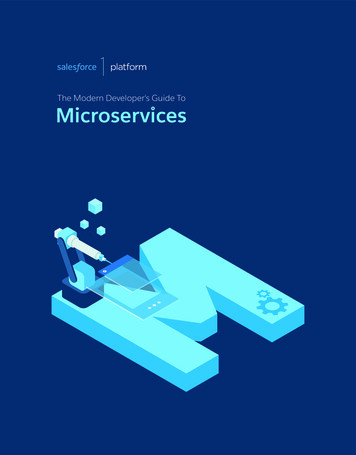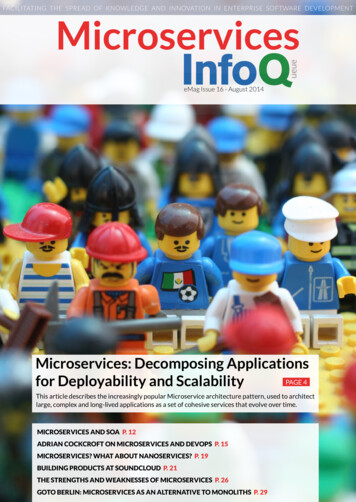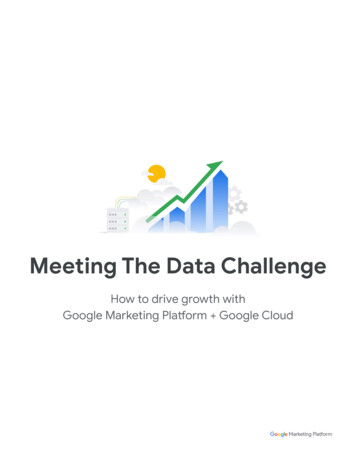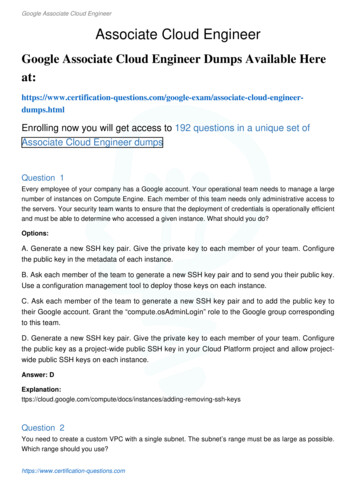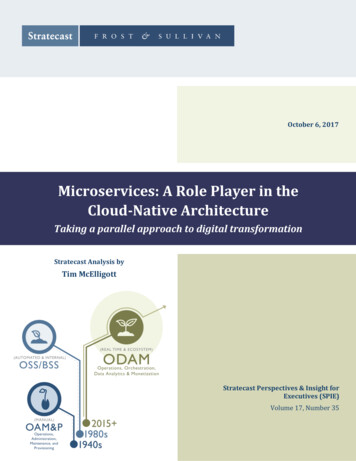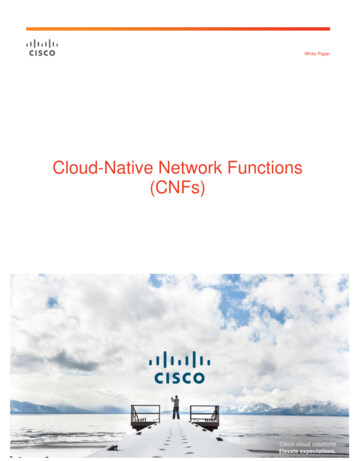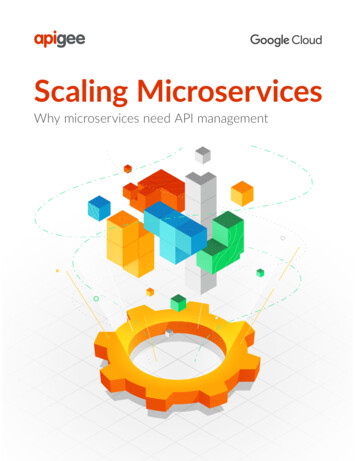
Transcription
Scaling MicroservicesWhy microservices need API management
Table of contentsExecutive summary . 03Why microservices are popular—and challenging . 04APIs make microservices shareable . 06Security: Manage microservices in a zero-trust environment . 07Reliability: Deliver performance and enforce SLAs . 08Adaptability: Build agile microservices for clean reuse . 09Summary . 10
Executive summaryThe original vision of microservices was that they wouldn’t be shared outside the small teamthat created them. Among the things that made them microservices, as opposed to applicationprogramming interfaces (APIs) or service oriented architecture (SOA), was the fact that developersno longer had to worry about the same level of documentation or change management that theydid with a more widely shared service.But as microservices have become popular for sharing and reusing services both inside anorganization and with external partners, they’ve evolved well beyond the original use case ofsharing functionality within a single development team. As enterprises have attempted to sharemicroservices, many have struggled to secure them, make them reusable and adaptable beyondbespoke use cases, and understand their usage, dependencies, and performance.Consequently, microservices have become like many other backend services that need to be managedand made consumable and reusable for developers. As is the case with these other services, thistask can be accomplished by packaging and managing microservices as APIs.Put another way, when microservices are lauded as catalysts for speed and scale, the conversationis incomplete if it does not include APIs—because without APIs, microservices cannot be securely,reliably, and adaptably scaled across an organization or to outside partners. Moreover, becausethese APIs and their microservices are meant to be widely consumed and reused, it’s not enoughfor companies to merely create the APIs and move on. Rather, the APIs should be continuallymanaged so the business can control how its microservices are accessed, generate insight intohow they are used, and encourage reliability of its services.03
Why microservices are popular—and challengingMicroservices. As the name implies, microservices are small and lightweight services that enablecomplicated applications to be broken down into components that can be developed by disparateteams. Individual components might provide payments functionality or geolocation functionality,for example.In a microservices architecture, applications can easily leverage and reuse existing microservicescomponents, and these components can be interconnected without fragile dependencies ortightly-coupled linkages. The potential benefits of using microservices include more developersworking on new applications and digital experiences, faster development, greater agility, andmore innovation.Microservices investments have accelerated across the business spectrum—not just among bigcompanies, a majority of which 1 are either experimenting with microservices or using them inproduction, but also among mid-market firms and SMBs.21DZone, “DZone Research: Microservices Priorities and Trends” by Anne Marie Glen, July roservices-priorities-and-trends2CRN, “Research: CIOs Up Spending On Containers, Microservices As Companies Increase Public Cloud Use” by Alec Shirkey, September as-companiesincrease-public-cloud-use.htm?04
Netflix’s iterative transition from a monolith to a microservices architecture, 3 which helped thecompany to make its content available 4 on a dizzying variety of screen sizes and device types, isone of the most famous microservices success stories—but hardly the only one.South American retailer Magazine Luiza has similarly leveraged microservices to accelerate thelaunch of new services, from in-store apps for employees to an Uber-like service to speed updeliveries. Its efforts have helped it earn praise as the “Amazon of Brazil”. 5 Pharmacy giant Walgreenshas likewise harnessed microservices to make its core functionality lightweight and user-friendlyfor developers, resulting in, among other things, more apps integrating the Walgreens customerrewards program and the distribution of billions of rewards points to customers. Other majormicroservices adopters, including Airbnb, Disney, Dropbox, Goldman Sachs, and Twitter, havecut development lead time significantly. 6But these and other noteworthy microservices accomplishments generally involve a major evolutionfrom the original microservices vision.Microservices were initially conceived as small, single-function services that were to be usedwithin a single team. These microservices were meant to exist outside the kind of centralizedgovernance and documentation characteristic of larger shared services, such as those built underservice-oriented architecture (SOA) principles. However, as more businesses have found thatmicroservices encapsulate functionality that is too valuable to be confined within a single team,they’ve also had to find ways to make microservices shareable.Additionally, companies have found that the complexity of managing microservices increases withthe number of microservices they deploy. Many businesses have struggled with security, with alack of visibility into usage and performance of microservices, and with building agile microservicesfor clean reuse. Challenges include bolstering security in a zero-trust environment, ensuring compliance, understanding microservices usage, improving the developer experience, and encouragingand increasing microservices adoption and reuse.3Netflix, “Engineering Trade-Offs and The Netflix API Re-Architecture” by Katarina Probst and Justin Becker, August -64f122b277dd4re/-fraction, “How Netflix works: the (hugely simplified) complex stuff that happens every time you hit Play” by Mayukh Nair, October e254b5Bloomberg Businessweek, “Hawking TVs on Tinder Helps Fuel 2000% Rally in Brazil Stock” by Fabiola Moura and Paula Sambo, August for-brazil-retailer6Computerworld, “How to determine when and why to use microservices” by Gary Olliffe, June 69/how-determine-when-why-use-microservices/05
APIs make microservicesshareableIncreasingly, organizations that conquer microservices management challenges and deploymicroservices to business advantage embracea common best practice: they package theirmicroservices as application programminginterfaces (APIs) to make them shareable andmanageable throughout the organization andwith outside developers.“A lot of different microservices work togetherto provide functionality for customers,” FerryTamtoro, CTO and VP Flex Digital Health, said inan interview. “The APIs provide a user-friendlyinterface for our customers so that they don’thave to access every single microservice.”In another interview, T-Mobile VP of IT ChuckKnostman offered a similar appraisal: “For everymicroservice we build, we actually produce anAPI.”Microservices and APIs are not synonymous and are not interchangeable concepts. In a certainrespect, microservices are similar to many other backend services that developers may need toleverage to create new applications. Because frontend developers cannot be expected to possessexpertise in all backend systems or to modify their work whenever backends change, enterprisesuse APIs to abstract systems complexity into an intuitive and consistent interface. Microservicesare no different in this regard.APIs are the mechanism that make data and functionality, including microservices, consumableand shareable. API management platforms provide the tools to secure these APIs, optimize theirreliability, encourage developer consumption with resources such as a developer portal, and adaptthem for evolving use cases.06
Security:Manage microservices in a zero-trust environmentThe very reasons for the success of microservices-based architectures may also present somechallenges; because microservices are often developed without the centralized oversight that onceexisted, they offer greater development speed and agility but also potentially increase security risks.Without consistent oversight, microservices may be deployed with varying levels of security—orno security at all.When a business packages microservices as APIs and manages them via an API managementplatform, the organization can implement security and governance policies, and control access toits APIs, with OAuth2, API key validation, and other threat protection features. In this way, anorganization can enable microservices to be consumed and reused throughout a zero-trustenterprise environment.07
Reliability:Deliver performance and enforce SLAsAn organization’s ability to deliver SLAs to consumers of its microservices may be hindered by alack of visibility into usage and performance of the microservices APIs. This problem is especiallyacute when these microservices are used by disparate teams in a large enterprise or by partnersand customers.API management platforms provide the analytics and monitoring capabilities that enableenterprises to measure microservices’ usage and adoption, developer and partner engagement,traffic composition, total traffic, throughput, latency, errors, and anomalies. These capabilities—along with a self-service developer portal that lets developers discover and experiment with APIs—help enterprises to give developers a first-class experience. Given that developers play a vitalrole in leveraging microservices for business results, their experiences may be just as importantas end users’.08
Adaptability:Build agile microservices for clean reuseMany existing and legacy services are not built for modern scale. Consequently, enterprises areadapting legacy services for modern use by breaking up monolithic applications into microservices.In most cases, however, there are already many applications taking advantage of services fromthe monoliths. The transition to microservices must be done in a way that makes it seamless—invisible to those other applications and developers using the monolith services.Furthermore, as mentioned earlier, microservices are typically purpose built for a particular use case.As soon as a microservice is shared outside of the small team that created it—let alone outsidethe company—developers need to be able to adapt the microservices to be more widely used.When a service is meant to be shared and reused across teams and even outside of a company,it can no longer exist just as a microservice—it should be packaged as an API.Modern APIs (RESTful, cached, and secured) can act as a facade for legacy SOAP services andmonolithic applications, and securely expose new microservices for consumption. A microservicebehind an API can be cleanly replaced without disruption to the applications that rely on the API.Mobile and web app developers can continue to consume an enterprise’s legacy services and beunconcerned with the heterogeneous environment behind the APIs or to any transition frommonolith app to microservices.09
SummaryEnterprises are modernizing and scalingtheir applications by breaking them upinto smaller components, or microservices,especially when used with cloud infrastructure. Microservices can increasesoftware development speed and agilitywhile enabling the reuse of shared services. The agility empowers developersbut may come at a price.When developers build microservices,they can deliver inconsistent and varyinglevels of security—or a complete lackthereof. Lack of monitoring and measurement can leave enterprises flying blindand unable to gauge how reliable theirsystems are. As microservices have becomemore popular and enterprises have begunto share them more widely with partnersand customers, the lack of control andvisibility can be dangerous.Because APIs provide secure access tofunctionality and services, when a businessneeds to share services—whether betweenteams all under the same roof or withdevelopers and partners outside theenterprise—it needs APIs. Companies areincreasingly looking to API managementplatforms to provide the security, reliability,visibility, and adaptability of the APIs inits microservices architecture, whether inthe cloud or across hybrid environments.10
Now that you’ve finished reading,why stop learning?TRUTH ABOUT MICROSERVICESTake a deeper dive into the concepts and strategies you’velearned to scale microservices by exploring more successstories, videos, eBooks, articles, and more.KEEP LEARNINGFREE TRIALExplore Apigee Edge, a full lifecycle API managementplatform that helps you manage the entire API lifecycle fromdesign through iteration and helps you control thecomplexity of microservices.TRY IT FREEMAXIMIZING MICROSERVICESLearn how a service mesh and API management platformcan allow your team to reduce complexity and increaseconsumption to maximize the value you get from yourmicroservices in this eBook.GET THE EBOOK11
Share this eBookon socialwith a colleague 2018 Google LLC. All rights reserved.
lack of visibility into usage and performance of microservices, and with building agile microservices for clean reuse. Challenges include bolstering security in a zero-trust environment, ensuring com- pliance, understanding microservices usage, improving the developer experience, and encouraging and increasing microservices adoption and reuse. 05
